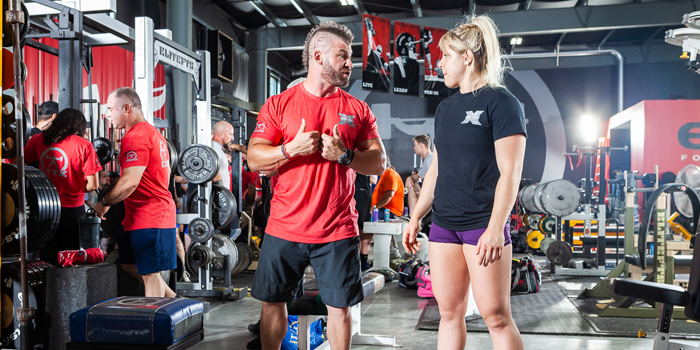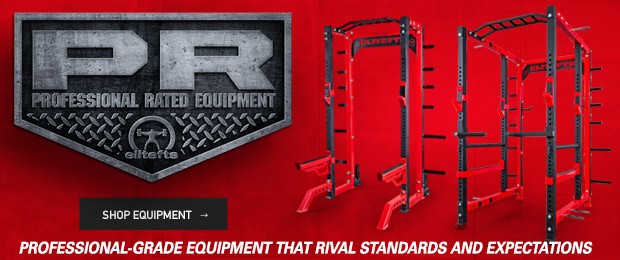
This may come as a surprise to many, but the exercise sports science field is extremely new. What I mean by that is, as a degree, it has only been around for roughly 25-30 years. This also means that the realm of strength and conditioning with backed scientific principles has been refined, and many different “forms” and progressions are being taught (similar to teaching styles in school). That last statement is key when it comes to this article. Everybody learns differently. This is my way of teaching clients and seminar attendees how to execute a squat (generally) in refining their technique. Everyone’s will be slightly different due to individual builds and physical limitations, but my goal is to educate them on finding what is best for them.
Starting From the Ground
We are going to start from the ground. One of the main reasons that I like to teach from the floor is because this is where we generate force. The human body cannot generate force unless it is pushing into an inanimate object. Let’s not get caught up with things like momentum. The best example I can give is if the body is suspended in the air without being tied to anything (think outer space), it cannot move unless acted upon by something. Thus, the floor is the best place to start our checklist as it will affect the rest of the “chain” going up the body.
Feet First
So let’s talk about feet first. Most people will either have a very flat foot or a foot with a moderately high arch. The goal here is to find a solid middle ground. If you have a flat foot, we will try and grab the floor with the pads of our toes WITHOUT curling them and create a higher arch. If your arches are already “high,” we need to grab the floor with the pads of our toes by pushing them down and out to flatten that arch. This gives us the most amount of surface area and stability within our foot, which is the front line of our force production. If this surface is not evenly grounded, the force will not efficiently be transferred up to our legs to our hips.
Force Transfer
Once our feet are set, we can now focus on how to properly transfer that force from the ground through our legs into our hips. This is going to come by way of external rotation. External rotation is the rotation of the leg AWAY from the midline of the body. You may have heard cues such as knees open, spread your taint, or twist. Ultimately, the goal is to turn your femurs outward to open the hip capsule and allow the hip to bear the load on our back. This also allows all the bony landmarks, where tendons are attached, to rotate out of the way.
RECENT: The Overall Structure of Conjuphasic
When external rotation does NOT happen, the femur pushes up into the hip socket. Some people have shallow hip sockets (where the ball of the femur is already “in” the socket), and some have deeper sockets (where the ball of the femur can actually travel deeper into the joint). We can actually test passive internal and external rotation to get an idea of where their anatomical structure falls. Regardless of how they test, external rotation needs to be applied. If done properly, the glutes are one of the muscle groups that aid with external rotation—the glute medius in particular.
Stand up and put your left foot out with your heel on the ground and toe up. Now rotate your foot outward away from your body. Feel that? That’s your glute firing. That’s great, but now we need to do this with our feet in contact with the ground. Now stand in your squat position. Contract the glutes and rotate the leg out towards the pinky toe WITHOUT letting your foot slide across the floor. When you do this, you should see your knee track “outward,” as mine does in the video. So first, grab the floor, second, squeeze butt and rotate into that pinky toe.
Glute Contraction
Let’s keep working up the chain to pelvis control and butt squeeze. We will now transition our focus onto glute contraction as it aids our hips into a stacked position. The glute medius helps with extra rotation, but the rest of our glutes will work hip extension, which also creates a posterior pelvic tilt. The majority of athletes and lifters will have an ANTERIOR pelvic tilt, which is not efficient to move while under load. I will go as far as to say it puts you at an increased risk of injury to the low back and hips. When we contract the glutes, it helps to correct this anterior tilt and make the pelvis more neutral. Now that we have our pelvis “tucked” under us and more stable, we are ready to lock it into position by taking our brace.
Breathing and Bracing
This is the point in time where I attempt to teach breathing and bracing in training. I always ask my attendees, "If I gave you a hand ax and told you chop down a tree, would you chop down a thick or a thin tree?” USUALLY, the answer is always a thin tree. Why? Because it’s easier! When we take a deep breath of air, and our shoulders rise upward, we are actually causing our stomach to sink inward like a thin tree. We want to do the opposite and make a thick tree. I ask people to mimic how they feel, with their stomach, after they eat a ton of food on Thanksgiving. They usually push their belly out, distending it. This pushing out motion creates a “large trunk” like a thick tree. So we first need to take a large breath WHILE we pull that air into our lungs by making the sides of our stomach pull outward, like our thick tree. We then can push outward—focusing on the sides of our stomach—like a pufferfish to initiate our brace and hold it. This sequence done after squeezing our butt SHOULD make your lower back feeling like the muscles are flexing hard and able to hold a load.
As a helpful reminder, breathing and bracing don't only focus on the frontal abdominal muscles you can see in your stomach. Your abdominal muscles or “core” wrap around you 360-degrees, just like the trunk of the tree. This is why I emphasize the side of your belly when breathing and pushing out. If you can get the lateral portion of your stomach to contract, you are more than likely getting your lower back contracted and protected.
This process is also going to be key in transferring the force from the floor through the lower portion of your body through the upper portion into the bar. From your hips down, your body is actually going through flexion and extension. From your hips up, the body is in an isometric contraction (which is a muscle contraction without movement). Think of this as an electrical current. If you turn on the light, the electrical current goes from the light switch through the wire to the light. If there is a cut in the wire, no light will turn on. Our force is the electrical current. Our wire is how rigid our body is. If we become relaxed in our trunk, that is equivalent to having a cut in the wire. The result? Our force cannot get to the bar in order to move the weight. Remember, we have the ground pushing back against us AND the load on our back pushing down on us, so a weak trunk means we will be compressed and folded from above and below.
1. Grab the floor
2A. Squeeze butt and rotate into the pinky toe
2B. Squeeze butt to correct pelvis
3. Thanksgiving breath and pufferfish to the sides
The above pelvis shift and bracing concept is going to initiate our stacked position. It also puts our lumbar spine into a neutral position.
We are now going to move to our thoracic spine and the next portion of our “stack.” A stacked position is hips under ribs under shoulders. This will be the strongest and most efficient anatomical position to hold a load on our back and transfer force to that load to move it.
To initiate this, we will pull the bar down towards our butt. In other words, we are looking to scapulary depress. Think lat contraction that you feel while doing a lat pull down. A common problem when locking in the lats is then being forced into spinal extension. To efficiently lock in the rest of our stack position, we need to pull our rib cage (or sternum) down towards our belly button. No, I am not telling you to go into flexion or look down, but I am telling you to move your ribs directly over your pelvis and under your shoulder capsule. If you attempt to keep your chest/ribs up, you are most likely having your pelvis behind your ribs, your ribs in front of your shoulders, and your shoulders behind your ribs. So now, the bar would be sitting over your shoulder and pelvis, but your ribs and mid-section are in front of the bar. This is not an efficient way to transfer force from the ground into the bar. Once we have pulled the scapula down, pulled the rib cage (sternum) down, and have shoulders externally rotated a bit, our mid-back should be locked in.
The last piece of our squat setup will be the cervical spine and possibly the easiest coaching cue. “Sexy Double Chin” is what I call it. We want to keep our upper back and cervical spine flat. Has anyone ever heard wherever you look while driving, you'll start to go in that direction? Well, squatting is very similar. If you look down, this will promote you to shift your weight forward. If you look up, this will promote you to go into more spinal extension and shift your weight back onto your heels. Ideally, your head should be neutral, taking your chin and pushing it into your throat. This results in all the extra skin on the front side of your neck to scrunch together and give you two skin rolls, AKA, the sexy double chin.
Squat Checklist Recap
1. Grab floor *per arch needs*
2A. Squeeze butt twist into the pinky toe
2B. Squeeze butt to correct pelvis
3. Thanksgiving breath and pufferfish to the side
4. Lats down and ribcage/sternum down
5. Sexy double chin
Hopefully, there are a few things in here that resonate with some of you and possibly stimulate conversation. Next time we will go over how to initiate the squat through hinging and actually squatting WHILE maintaining the above setup.











2 Comments